Ever seen a surreal gleaming patch on a dead tree trunk? Welcome to the dreamy world of Glow in the Dark Mushrooms!
There is so much more to mushrooms beyond their cute umbrella tops and juicy stalks. Surviving in the harshest terrains, these ancient OGs never cease to amaze! Today, we take a look at another wondrous feat with glow-in-the-dark mushrooms!
Why do some Mushrooms Glow in the Dark?
Over 113 fungi species that grow mostly on decaying wood are known to produce a bluish-green light in the dark. Much like fireflies that light up especially to mate, these species emanate a neon glow to attract insects that then help spread their spores.
This cool, pale light is triggered by a reaction between luciferase, an oxidative enzyme, and luciferin, the light-emitting compound in bioluminescent organisms.
In fact, Aristotle noted as early as 383 BC that this light, unlike fire, was cold to the touch! And this chimeric process is called foxfire or fairy fire in the world of mycology.
While some are luminous on their fruiting bodies, some light up in their mycelia. Since it is an energy-exhaustive process, mushrooms tend to glow brighter in the dark when it is most needed and effective. In this article, we shed light on such 11 mushroom species that shed light!
Mushrooms
1. Bleeding Fairy Helmet

Botanical Name: Mycena haematopus
Named after its small, peachy burgundy caps that bleed a dark red liquid when cut, the Bleeding Fairy Helmet emanates a faint glow in the dark from its fruit body. With scallop-edged caps, they appear in magical clusters on decaying barks, especially of the beech tree.
2. Little Ping-Pong Bats
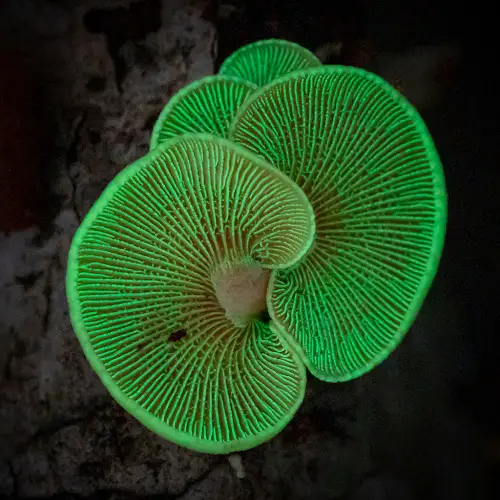
Botanical Name: Panellus pusillus
Another glow-in-the-dark mushroom from the Mycenaceae family, Little Ping-Pong Bats, can be spotted on almost every continent except Africa and Antarctica! They are tiny and fan-shaped, reminiscent of table tennis paddles, and that’s how they got their unique name.
3. Ghost Fungus
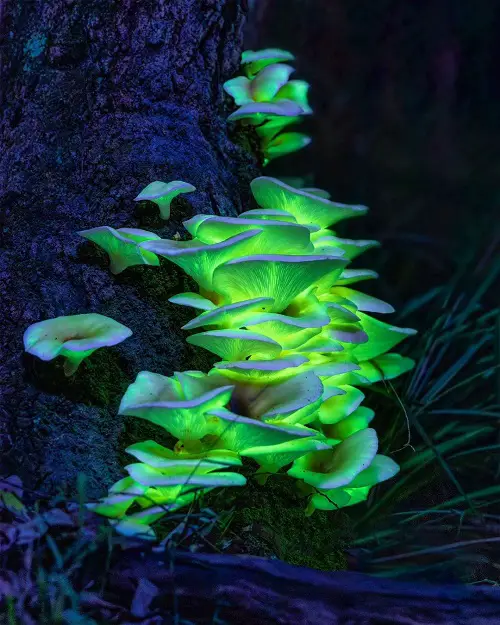
Botanical Name: Omphalotus nidiformis
Resembling the edible oyster mushroom, Ghost Fungus has a large, cream-colored cap that turns brownish with age but is quite toxic. The brown patches mix into black and are pale, supposedly like ghosts. These nest-shaped bioluminescent shrooms feed on dead or dying trees and glow at night.
4. Jack-O’-Lantern Mushroom
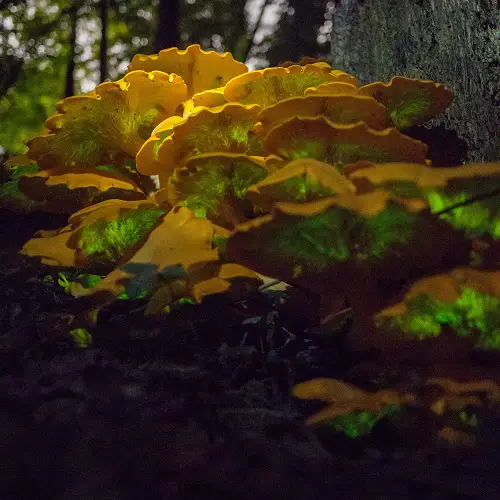
Botanical Name: Omphalotus olearius
If you wish to see the glow of the Jack-O’-Lantern Mushroom, look for a fresh and young specimen in the dark. The bright orange cap and gills of this mushroom exude a slight glow. However, do not even think of munching on these mushrooms, as they are toxic as well. If you’re looking for edible ones, check out this list.
5. Eastern Jack-O’-Lantern Mushroom
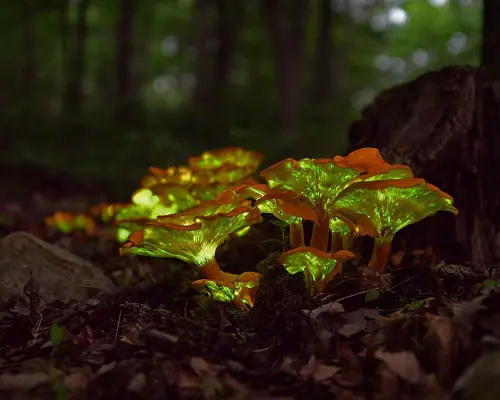
Botanical Name: Omphalotus illudens
Just like its cousin on top, the Eastern Jack-O’-Lantern Mushroom shares all the same physical traits. The only difference is that it grows on the Eastern coast of North America, while the regular one is found throughout Europe and Africa. This mushroom emits a greenish glow in the dark thanks to its bioluminescent properties.
6. Bulbous Honey Fungus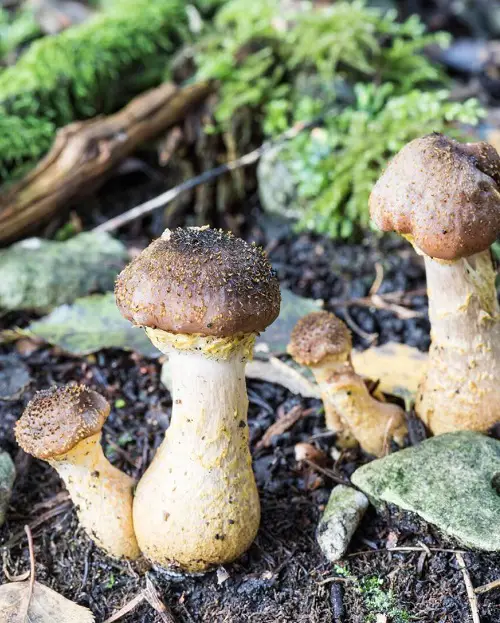
Botanical Name: Armillaria gallica
Bulbous Honey Fungus is a subterranean shroom with yellowish-brown caps and bulbous stems. It is known to form huge underground networks that can spread over large areas.
In fact, its fame comes from the “humongous fungus” attraction in a Michigan forest, where a colony spread over 37 acres! The mycelia of this mushroom glow with a greenish tint, so just imagine how unreal this vast expanse would look!
7. Eternal Light Mushroom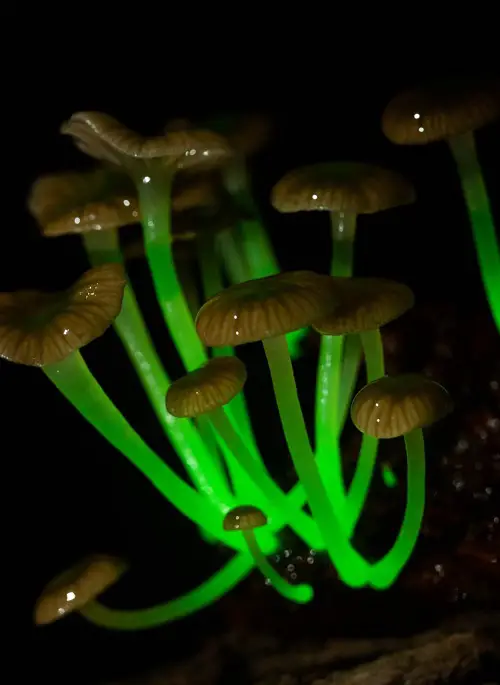
Botanical Name: Mycena luxaeterna
The Eternal Light mushroom is the complete opposite of the variety above in bioluminescent aspects. Only the stipe (stalk) of the mushroom glows brilliantly in the dark. It is small and delicate, with a long stem and a translucent brownish ivory cap.
8. Lilac Bonnet
Botanical Name: Mycena Pura
Glowing or not, this mushroom will surely catch your eye! In the day, the light purple color sets it apart from its surroundings, while at night, the chemical reaction from oxyluciferin molecules gives it a fluorescent shimmer. Slimy to the touch, this one smells a bit like radishes.
9. Green Pepe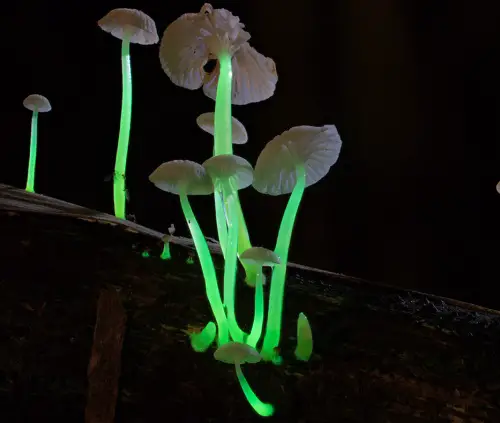
Botanical Name: Mycena chlorophos
If you see slender tubes of bright greenish glow emerging from a rotting tree, you must have found a Green Pepe mushroom. Sadly, its bioluminescence fades with time, and the best time to witness its glow is when the mushroom is just a day old.
10. Honey Mushroom

Botanical Name: Armillaria mellea
This mushroom secretly glows in parts that can’t be seen by the human eye! You can identify one by its honey-colored cap and thick, ringed stem. Unlike most on this list, this mushroom is finally an edible one! But keep it away from your favorite trees, as it can cause their roots to rot.
11. Bitter Oyster
Botanical Name: Panellus stipticus
Saving the best for last, the Bitter Oyster glows in the dark and how! These mushrooms have small, fan-shaped caps that are beige to pale brown and grow on decaying wood. But the real magic happens during deadly black nights when their incandescent green gleam truly comes to life.
If you love mushrooms as much as we do, check out our article on edible mushrooms that grow on trees as well, and comment if you’ve ever witnessed a glowing mushroom!




